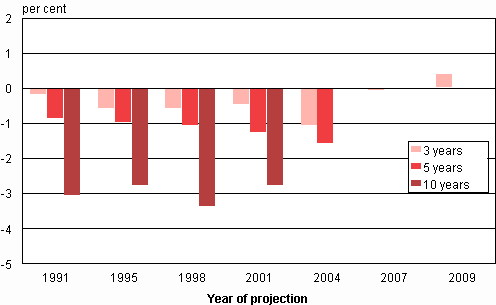Published: 28 September 2012
Projection for the number of persons aged 65 or over slightly lower
In Statistics Finland's new population projection, the number of persons aged 65 or over will in future be slightly lower than in the previous population projection. As a result of the mortality development in the years 2009 to 2011, the newest projection puts the number of persons aged 65 or over in 2040 nearly three per cent lower than in the projection released in 2009.
On the longer term, population projections always assess the lowering of mortality smaller than it actually is. In the population projections made in the years 1991 to 2004, the projection for the number of those aged 65 or over has been 0.9 to 1.6 per cent too low over the five-year projection period compared to the actual development. In the population projection made in 2007, the projection deviation was 0.0 per cent in the five-year projection period.
Projection deviation for the number of persons aged 65 or over from the actual development in population projections in three, five and ten-year projection periods

Proportion of working-age population is getting smaller
The number of people of working age is forecast to decrease by the year 2030 by 117,000 persons from the present one. According to the projection, the number of working-age persons will start to go up slowly after that. The proportion of people of working age in the population will diminish from the present 65 per cent to 58 per cent by 2030 and to 57 per cent by 2060. In 2060 the number of people of working age would be nearly the same as at present, but the proportion of people of working age in total population would be nine percentage points lower than now.
The so-called self-sufficiency forecast describes a situation where there would be no immigration and emigration at all and only the birth rate and mortality would influence the age structure. According to the self-sufficiency forecast, the number of people of working age would go down by the year 2030 by 393,000 persons and by the year 2050 by 556,000 persons.
Demographic dependency ratio weakens
The proportion of persons aged 65 or over in the population is estimated to rise from the present 18 per cent to 26 per cent by 2030 and to 28 per cent by 2060. The demographic dependency ratio, that is, the number of children and pensioners per one hundred persons of working age, will go up in the near future.
At the end of 2011, the demographic dependency ratio was 52.9. According to the projection, the limit of 60 dependents would be reached in 2017 and that of 70 dependents by 2028. In 2060 the demographic dependency ratio would be 77.
Statistics Finland's projection is a trend calculation
Statistics Finland’s population projections are demographic trend calculations based on observations on past development in the birth rate, mortality and migration. The projections do not seek to estimate the effect of economic, socio-political regional policy and other such factors on population development. The calculations mainly indicate the outcome from the present development under the assumption that it continues unchanged. Thus, they should not be interpreted as descriptions of the inevitable. The task of a population projection is to provide tools with which decision-makers can assess whether measures need to be taken to influence the development.
The projection has been made for the whole country up to 2060 and regionally up to 2040. The projection is based on the assumption that the birth rate and migration gain from abroad remain at their observed levels and the observed lowering of mortality will continue. According to the projection, the annual number of deaths will exceed births in 2032, but net immigration is assumed to sustain population growth even after this. The volume of net immigration is assumed to be 17,000 persons per year.
Source: Population Statistics 2012, Statistics Finland
Inquiries: Markus Rapo 09 1734 3238, vaesto.tilasto@stat.fi
Director in charge: Jari Tarkoma
Publication in pdf-format (302.0 kB)
- Tables
-
Tables in databases
Pick the data you need into tables, view the data as graphs, or download the data for your use.
Appendix tables
- Figures
-
- Appendix figure 1. Demographic depedency ratio 1865 - 2060 (28.9.2012)
- Appendix figure 2. Population by age and gender 2011, actual (28.9.2012)
- Appendix figure 3. Population by age and gender 2030, projection 2012 (28.9.2012)
- Appendix figure 4. Population by age and gender 2050, projection 2012 (28.9.2012)
- Quality descriptions
Updated 28.9.2012
Official Statistics of Finland (OSF):
Population projection [e-publication].
ISSN=1798-5153. 2012. Helsinki: Statistics Finland [referred: 20.12.2025].
Access method: http://stat.fi/til/vaenn/2012/vaenn_2012_2012-09-28_tie_001_en.html

